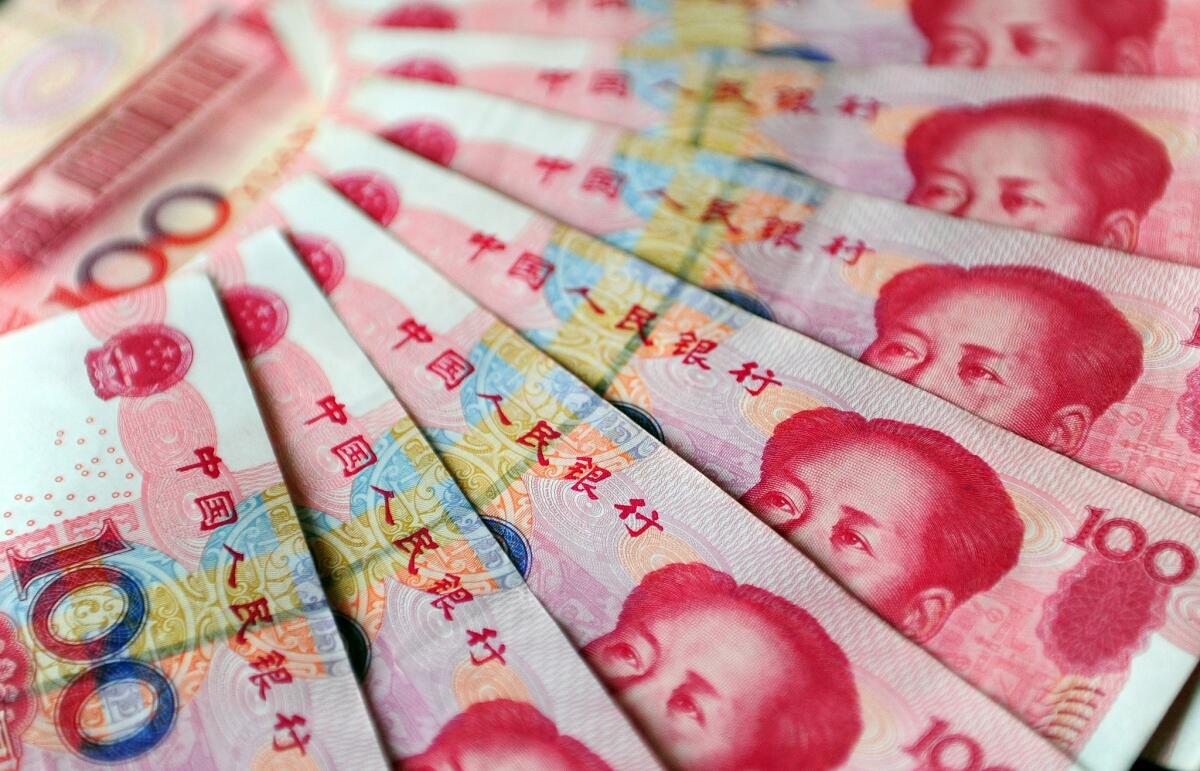Op-Ed: China pioneers a national digital currency. Can the U.S. catch up?

- Share via
While much of the world is consumed by the COVID-19 crisis, the Chinese government is quietly unleashing a financial innovation that will reshape its economy and improve its strategic standing for decades to come. In April, China’s central bank introduced the “digital yuan” in a pilot program across four cities, becoming the world’s first major economy to issue a national digital currency.
The contrast this past month between Beijing and Washington is telling. While Chinese leaders achieved an important milestone in modernizing their payments system, the Trump administration was focused on including the president’s name on paper stimulus checks.
The digital yuan will eventually replace cash in circulation, likely interfacing with popular payments platforms such as AliPay and WeChat Pay and the existing banking system. In an economy in which more than half a billion people already use mobile payments, the transition to a national digital currency should be seamless. But there’s a critical difference: Unlike privately issued forms of digital cash in wide use today, like mobile payments and credit cards, the digital yuan is the liability of the state, like cash.
The move from paper to bytes is more than just a sign of our digital times. Chinese leaders are making a strategic choice to achieve both a vastly more efficient administrative state, and the ability to dictate the terms of 21st century economic diplomacy by setting the standard for digital monetary systems.
In contrast, more than a month after Congress passed a $2-trillion coronavirus relief package, outdated technology and an ill-planned rollout have prevented many American households and businesses from receiving relief. Taxpayers have reported such issues as payments being sent to incorrect back accounts, missing amounts for dependent children and difficulties tracking the status of stimulus funds online. Of the 20 million households still awaiting relief, many do not file electronic tax returns and do not have direct deposit arrangements with the IRS. A federal government survey estimated that over 8 million American households don’t have any kind of bank account. Paper checks may not reach these households — among the most vulnerable to economic stress — until late summer.
Taking a page from China’s playbook, a digital dollar could help address many of these issues. Government-provided “digital wallets,” no-fee accounts maintained by the government for all taxpayers, can solve problems of financial inclusion and access, ensuring that individuals and businesses underserved by the banking industry can participate in the digital economy. Digital stimulus payments could appear in Americans’ wallets hours or days after Congress has approved them, instead of weeks and months. The government could track every dollar in circulation, giving it information about how the economy is growing and where stimulus efforts are most needed. In non-crisis times, the digital dollar could ensure faster delivery of government-managed welfare payments and increase efficiency and lower costs of digital payments in the wider economy.
More importantly, the risk of inaction could diminish America’s strategic influence. Without a digital currency offering of its own, the U.S. could find itself fighting a global campaign to prevent the proliferation of Chinese technology, much like it is doing today with Huawei’s 5G communications infrastructure.
A survey by the Bank of International Settlements found that the majority of the world’s central banks have begun exploring a national digital currency. As China further refines its digital yuan architecture, nations seeking to leapfrog development of digital currency and payments systems will likely seek out Chinese, not American, financial technology.
Chinese firms at the forefront of digital-payments technology will capture the economic gains of a rapidly digitizing global economy. China’s central bank will have a panopticon view of all transactions, not just those completed in the digital yuan, but in all digital currencies that leverage its technology, further strengthening its information advantage. Chinese cooperation, while already important, will become critical to the United States’ ability to monitor illicit-payments flow and levy economic sanctions.
The U.S. should move to bolster its competitiveness in the digital economy. An early version of the House stimulus bill to blunt the impact of the coronavirus pandemic, and a subsequent bill introduced by Sen. Sherrod Brown (D-Ohio), both proposed establishing a digital dollar to disburse economic stimulus payments. While neither was ultimately approved, it was an encouraging start. Congress should include the digital dollar in the proposed infrastructure bill or other upcoming stimulus packages. The effort could begin by defining a working group composed of the Federal Reserve, Treasury and relevant regulatory agencies to fully explore the legal, operational and policy challenges of the currency.
The U.S. financial system was once considered unrivaled, but COVID-19 has exposed a network of outdated and inefficient technologies. Among the many lessons from this crisis, one will be that the U.S. must invest in its financial infrastructure to promote economic growth at home and its strategic influence abroad.
With a structured approach to innovation, it’s not too late for the U.S. to catch up.
Aditi Kumar is executive director of the Belfer Center for Science and International Affairs at Harvard Kennedy School, where she runs the Economic Diplomacy Initiative.
More to Read
A cure for the common opinion
Get thought-provoking perspectives with our weekly newsletter.
You may occasionally receive promotional content from the Los Angeles Times.










